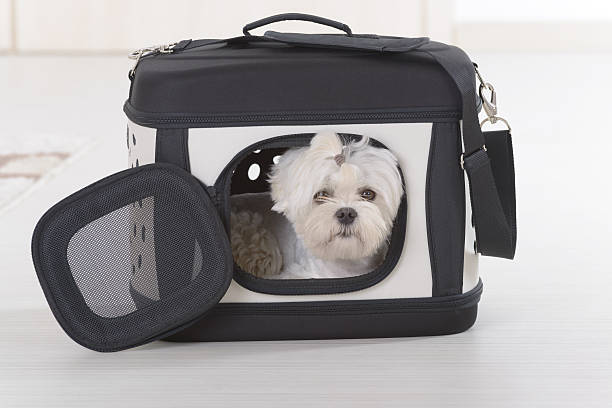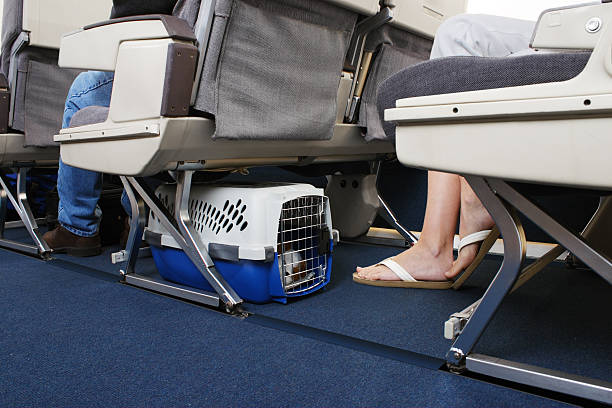You know how the rich lady in the movie always flies with a cute dog in the cabin? Yeah, it doesn’t actually work like that! It is possible, though, and very different from flying them as Excess Baggage or Cargo. (To know which method is best for you, see How To Fly Your Pet Overseas). Let’s take a look at flying your pet In-Cabin. When a pet travels In-Cabin, they fly in place of your carry-on bag and don’t leave your sight, which eliminates a lot of the stress factors compared to the alternatives. There’s plenty to do, so start planning early.
When should your pet not fly In-Cabin?
Not all pets can or should fly with you in the plane. First and foremost, they are limited by their size. Your pet crate must fit under that space of the seat in front of you without protruding into your or anyone else’s legroom. This space varies depending on the aircraft, so when you call the airline to make your reservation, be sure to ask for the measurements of the space beneath the seat to ensure your crate will fit. However, even though your crate fits, your pet might not. Read on for more details.
Most airlines have a minimum age for the pets they allow onboard; this varies by airline, and regulations are constantly changing, so ask your airline representative for specifics. Also, the breed matters. Both airlines and countries may restrict certain breeds from entry—typically these include those breeds considered aggressive (for the country) and those with snubbed noses due to their breathing difficulties (for the airlines). The agent will probably ask what breed but might not. Don’t be caught by surprise; if they don’t ask, you must.
If your pet is not in good health, it obviously should not fly. When you see your veterinarian to get the health certificate for your pet (see How to Fly Your Pet Overseas), they will determine if your pet is in good enough health to fly.
This may seem obvious, but if your four-legged friend will cause a disturbance to the people around you, they should not fly In-Cabin. Our cat cried relentlessly every time we put her in her crate no matter the length of the trip. No way was I going to subject my fellow passengers to hours (and hours, overseas flights are long!) of a crying cat. Pets are not allowed out of their crates during the flight, so you will not be able to comfort them. Just be mindful of the people around you and remember many have pet allergies.
The length of the trip matters. Some airlines will not allow pets to be In-Cabin on the longer overseas flights. If this applies to you, you may need to change your departure or destination airport and make other arrangements for part of the trip.
Reservations
Just because your pet crate is in leu of your carry-on does not mean you do not need a reservation for your four-legged friend. In-Cabin pets are limited in number on all aircrafts, and usually by section of the plane. In addition, there are many seats on the plane where they are not allowed, so you will have to pick your seat accordingly. For example, they are not allowed in those coveted bulkhead seats and emergency exit rows, and some airlines do not allow pets in the back rows of the aircraft.
Cost
Even though the pet crate is your carry-on (you are usually still authorized a personal item), there is also a fee attached to flying with your pet. Ask the airline the cost (usually $100 and up), as well as how and when to pay. Pet passage is almost always paid when you check-in, so be prepared.
The Crate
As mentioned above, the size of your crate is limited as it must be able to fit under the seat in front of you. This does not mean you can stuff a large cat into a small crate. The animal flying must be able to sit, stand and lie down without touching the top or sides of the crate.
When a pet travels as Cargo or Excess Baggage, the crate requirements are strict. There is a little more leeway with an under-the-seat crate. It does not have to be made of sturdy material, as long as it is ventilated on all sides and is waterproof. One thing to keep in mind, however, is that you will need room for food and water in the crate (and a small litter box if you are traveling with a cat).
Travel Day
Be sure to give your pet the opportunity to relieve themselves before you check them in. You will need to have all of your pet paperwork on hand (see How To Fly Your Pet Overseas for details), and be prepared to pay the extra fee for your pet at this time.
Security: In-Cabin pets will go through security but not through the x-ray machine. As you go through security, remove your pet from its crate and hold it as you walk through the scanner. Please be sure to have an identification tag on your pet and have them attached to a leash, just in case they wiggle free as you remove them from the crate. The pet crate will go through the x-ray machine as would a carry-on bag. After you, your pet, and their crate make it through security, put your furry friend back in the crate, where they will stay until you arrive at the airport at your destination. Pets are not allowed out of their crates anywhere in the airport except when they go through security and at designated pet relief areas.
Note: many airports have become more pet friendly & have pet relieving areas inside and outside of the airport. Ask before you arrive if these areas exist at your airport and where they are located.
If you are well-prepared and your pet is well-behaved, flying with them in the cabin of the plane does not have to be overly stressful. Do your research, confirm it with your airline, re-confirm with your airline (yes, you WILL hear different requirements from different agents), and have a great trip!


